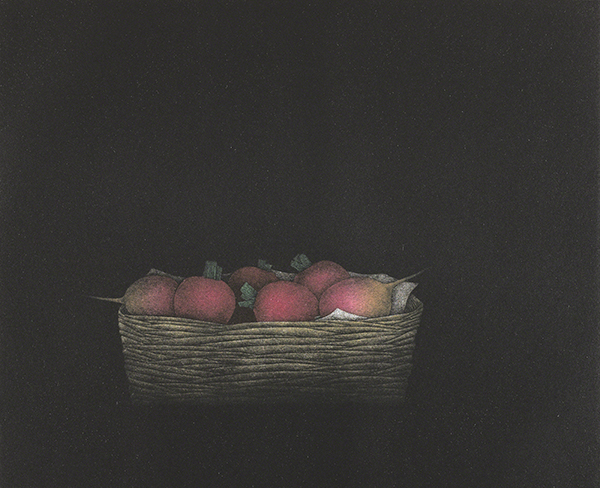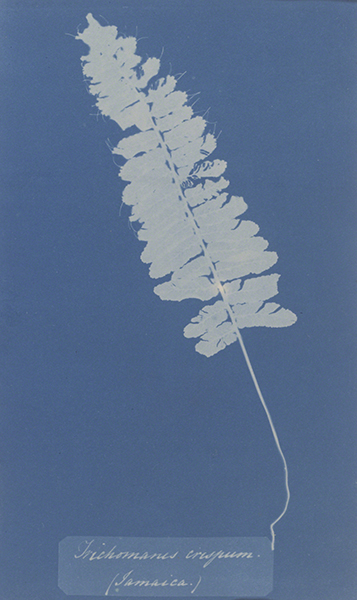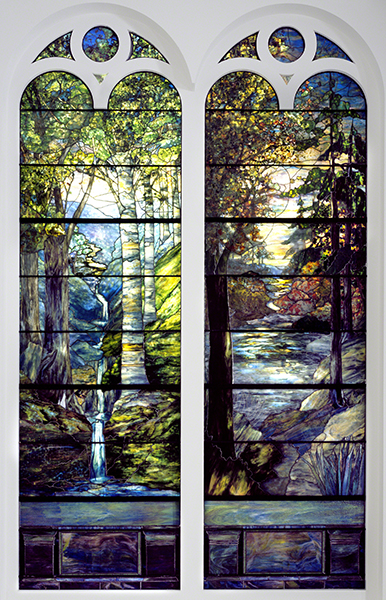Women's (Art) History Month: Tomoe Yokoi, Anna Atkins, and Agnes Northrop
This week of Women’s Art History Month, we’ll look at a printmaker, a pioneer photographer, and one of the secrets to Tiffany’s success in stained glass.
 |
| Tomoe Yokoi (born 1943, Japan), Turnips, 1979. Mezzotint on paper, 10 ¾" x 13 1/8" (27.3 x 33.3 cm). Brooklyn Museum. © 2020 Tomoe Yokoi. (BMA-4620) |
After World War II (1939–1945), printmaking ascended as a vital medium in Japan because of the value on mass-production. New printmaking techniques did not have full impact until the 1950s. The generation after Hiroshima found a treasure trove of new technologies for printing, from mezzotints to silkscreen. New processes were enthusiastically absorbed. New photo print methods were also explored. Contemporary Japanese printmaking burst with ingenuity.
Tomoe Yokoi was born in Nagoya, Japan. She studied at Bunka Gakuin Tokyo College of Art until 1964, where she learned traditional relief printing (woodcut) and subject matter. Everyday images of fruit, musical instruments, and flowers would become the staple of her prints. In 1964, she moved to Paris to study with Stanley Hayter (1901–1988, British) at his Atelier 17. There, she learned mezzotint techniques. Hayter was a Surrealist and subsequently Abstract Expressionist, both a painter and printmaker. Yokoi honed her intaglio printing techniques while studying with him.
In 1971, Yokoi moved to New York, having perfected the printing method of mezzotint. She expanded the range of the mezzotint to multiple-plate images with subtle nuances of color. This work is typical of Yokoi's still-life prints—realistically rendered objects isolated on a dark, blank background. She unites the Japanese reverence for nature with the Western still-life tradition.
Much like Dutch and Spanish Baroque still life painting, Yokoi isolates her forms in a way that renders them almost meditational in spirit. At the same time, she reflects something of Hayter's Surrealist bent with the eerie suspension of the subject in a dream-like void.
Mezzotint means “half-tone,” which indicates that the technique can create a series of different tones or values without using drawing techniques such as stippling or hatching. A tool called a rocker is used to create texture on the plate. The more textured the plate, the darker it prints. Yokoi uses the “dark to light” method, in which the entire plate is covered by rocker texture, and areas—such as the turnips and basket above—are burnished (smoothed through scraping) so that they print lighter.
 |
| Anna Atkins (1799–1871, Britain), Trichomanes crispum (Jamaica fern), ca. 1850. Cyanotype on paper, 8 ¼" x 5" (21 x 12.7 cm). © 2020 Brooklyn Museum. (BMA-5597) |
During the 1800s, unlike painting and sculpture, photography did not require training in the academies, long apprenticeships, or lengthy practice. For these reasons, women were encouraged by photographic journals to use the medium. They would not need to be exposed to nude models in the academies, and they could practice the art form from home, still considered the most “appropriate” place for women.
Anna Atkins was the daughter of a respected British zoologist and chemist. While still young (1823), she illustrated a book about shells translated by her father. Through membership in the Royal Society, she met William Henry Fox Talbot (1800–1877) and John Herschel (1792–1871), who were developing some of the earliest experiments in photography.
Atkins settled on the cyanotype, an early form of photogram, which is also called “sun printing.” The object to be recorded is laid on paper impregnated with ferric ammonium citrate and potassium ferricyanide, then exposed to sunlight. This creates a positive image of the object, sort of like a shadow, and the negative space around it turned a beautiful cyan blue. Her first published study that included cyanotype illustrations was British Algae: Cyanotype Impressions of 1843, probably the earliest "book" illustrated with photography. In the 1850s, she published a three-volume book on Cyanotypes of British and Foreign Flowering Plants and Ferns, from which this beautiful example comes. The series of books contains 389 captioned cyanotypes.
 |
| Agnes Northrop, designer (1857–1953, US) and Tiffany Studios (1902–1932, Corona, NY), Dawn in the Woods, Springtime, 1905. Stained glass, 12'6" x 3'7" (381 x 109.2 cm). © 2020 Brooklyn Museum. (BMA-5610) |
When one sees Tiffany stained glass windows, is it a natural assumption that Louis Comfort Tiffany (1848–1933) designed them? It should not be, because he had a staff of designers, such as Agnes Northrop who did watercolor studies for these windows. Like the American “art pottery” renaissance of the late 1800s, women played a major role in Tiffany’s stained-glass business, and Northrop in particular. She designed many of Tiffany’s landscape windows, which was a Tiffany specialty and totally revolutionary in the history of stained glass. Like historical stained glass, these landscape windows by and large were meant for churches, particularly Protestant churches that frowned upon images of saints. Landscapes like this were symbols of Paradise, with the rising sun a natural symbol for Jesus who was referred to as the “light of the world.”
Northrop was born in Flushing, Queens, and probably met Tiffany in the 1880s. Queens was the center of one of Tiffany’s studios. She was not just one of the “Tiffany women,” a group who precisely cut pieces of colored glass for a variety of Tiffany products. Northrop held a more privileged position in the firm, having her own office in which to design windows. Her designs received international recognition, and she received a silver medal at the Paris World’s Fair in 1900 for her window designs. At the time she lived in Queens it was a center of nurseries and gardens, which no doubt inspired many of her designs. She is believed to have worked in Tiffany’s studio for about fifty years.


Comments